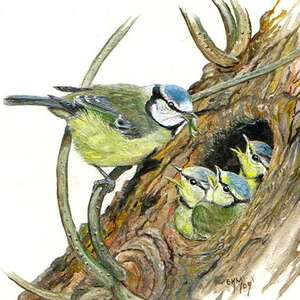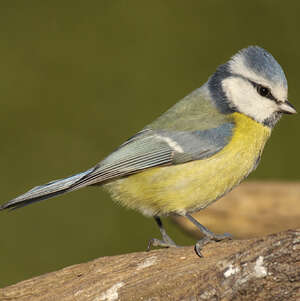Eurasian Blue Tit
Cyanistes caeruleus - Mésange bleue
Identification
The Eurasian Blue Tit is a small tit that gets its name from the blue colour of its cap, wings and tail. Its head is remarkable. The face, largely white, is barred by three darker blue to black lines, two lateral lines passing through the eye to reach the same colour at the nape, and a wide gular line reaching a collar, which in turn borders the white cheeks to reach the nape. Adult males are distinguished by the bluer plumage, especially on the cap. Female blues are paler. The mantle is yellow-green. A white line can be seen on the wing at the level of the larger coverts. The lower parts are yellow-lemon with a hint of a blackish median line on the lower chest and upper belly, reminiscent of its cousin, the Coal Tit, but less marked. The eye is dark. The beak and feet are bluish-grey.
The juvenile is duller than the adult. The cap is greyish and the mantle is less green. A yellow tint invades the white head. The lower parts are whitish. The feathers will start to be coloured from the post-juvenile moult.
Subspecific information 9 subspecies
- Cyanistes caeruleus caeruleus (n, c and e Europe to w and n Asia Minor)
- Cyanistes caeruleus obscurus (British Isles)
- Cyanistes caeruleus balearicus (Mallorca)
- Cyanistes caeruleus ogliastrae (Iberian Pen., Corsica and Sardinia)
- Cyanistes caeruleus calamensis (s Greece, Cyclades, Crete and Rhodes)
- Cyanistes caeruleus orientalis (se European Russia)
- Cyanistes caeruleus satunini (Crimean Pen., Caucasus, e Turkey and nw Iran)
- Cyanistes caeruleus raddei (n Iran)
- Cyanistes caeruleus persicus (sw Iran)
Foreign names
- Mésange bleue,
- Herrerillo común,
- chapim-azul-eurasiático,
- Blaumeise,
- kék cinege,
- Pimpelmees,
- Cinciarella,
- blåmes,
- Blåmeis,
- sýkorka belasá,
- sýkora modřinka,
- Blåmejse,
- sinitiainen,
- mallerenga blava eurasiàtica,
- Blámeisa,
- modraszka (zwyczajna),
- zilzīlīte,
- plavček,
- Лазоревка,
- アオガラ,
- 青山雀,
- blåmes,
- 歐亞藍山雀,
Voice song and call
The vocal repertoire of the Eurasian Blue Tit is very diverse and difficult to transcribe. It emits very high-pitched tsi contact calls, quite similar to those of other tits and even wrens. The usual calls can be transcribed as si si si, si lu lu lu lu lu lu, ch ch ch ch ch du, tche he he he he he, with many variations on these themes. A territorial psi psi du du du du du has the value of a song.
Habitat
The Eurasian Blue Tit is a woodland species whose ecological optimum is in deciduous forests. This is typically the bird of the oak forest in Europe.
Behaviour character trait
The Eurasian Blue Tit is a very active and agile small bird. It is constantly moving around in search of food. It has its own way of moving around in tree-tops, with acrobatic positions enabled by its sharp claws. It hangs down at the end of branches, head down, and explores the buds and fruits of different seasons. When it is done with a twig, it settles on the next one that undergoes a characteristic rocking motion.
During the breeding season, the Eurasian Blue Tit forms territorial couples. Despite its small size, it is brave and can be aggressive towards other small intruders that compete with it, especially when it comes to nesting sites.
The Eurasian Blue Tit looks for food in the trees, usually higher than other members of the family and rarely descends to the ground. At night, the Eurasian Blue Tit stays in dense ivy or in sheltered places like hollows or holes when the weather is bad.
After the emancipation of the young and for the whole inter-nuptial period, the Eurasian Blue Tits form groups with other tit species, creepers and kinglets, wandering in search of food, first in the forest, then, when the cold sets in, getting closer to urban environments where they know they can find supplement food.Eurasian Blue Tits frequent bird feeders often, enjoying fat and oily seeds. It is a partial migrant in Europe. Birds in our region are usually sedentary, but the populations living in northern and northeastern Europe are affected by fairly large movements in a southwest direction across the continent.
Flight
The Eurasian Blue Tit has a quite slow and somewhat hesitant flight, due to a succession of rapid beats interspersed with brief pauses. It makes short flights from one tree to another, suddenly stopping on a perch. But during migratory movements, the loose small groups she then forms fly over longer distances and quite high, with a sustained flight.
Dietfeeding habits
In the spring, the Eurasian Blue Tit is predominantly insectivorous. A good portion of its diet consists of moth caterpillars, particularly during the rearing of its young.
In this way, it can play a beneficial role, along with other tit species, during outbreaks of pests such as the Oak Processionary Moth. Aphids are also highly sought after. In fact, it can tackle a wide variety of small invertebrates. In the non-breeding season, the species becomes markedly granivorous and frugivorous, while still maintaining its insectivorous habits due to the hardiness of insects (eggs, pupae). It can cause damage in orchards by attacking buds and fruits, but this is largely offset by its consumption of insects. Trees such as willows and poplars play an important role in its diet. At the time of the abundant spring flowering, the birds take nectar and pollen, as well as the insects that come to collect pollen. They also know how to drink the sap that flows from wounds caused by woodpeckers or certain insects. Finally, in the in-between season, they feed on the numerous seeds.Reproduction nesting
The Eurasian Blue Tit breeds from April to July. It is a cavity-nesting species and builds its nest in any suitable-sized cavity as long as its entrance is small enough to avoid larger competitors like the Carrion Crow.
The most common example is a hole in a tree, but it can also use a rocky cavity in a cliff, a wall, or a quarry face. In fact, any cavity that can contain its nests may be chosen, such as pipes, hollow posts, concrete blocks, etc. It is also willing to use artificial nest boxes. The nest is made of moss, dried grass, and other plant materials and lined with animal fur. The clutch consists of 9 to 13 eggs and incubation does not exceed 15 days. Only the female incubates, the male providing food while the female incubates. The young are fed by both adults. They fledge at 19-20 days of age but are not completely independent until four weeks later. A second clutch at the end of spring is regular in most of its range. The species has some predators of its nests such as squirrels and woodpeckers.Geographic range
The Eurasian Blue Tit is a predominantly European species. It occupies the entirety of the continent, except for the northern parts of Fennoscandia. Its area extends a little bit beyond the Volga River in western Russia. In the southeast, it can be found in Anatolia, the Caucasus and as far as Iran.
The Eurasian Blue Tit is largely considered to be a sedentary species, but post-nuptial migration studies showing clear shifts of this species where the northernmost populations may be migratory.
Recent genetic studies have shown that Eurasian Blue Tits form two distinct groups, with each of them constituting a good species. From now on, Cyanistes caeruleus in Europe, which is the subject of this article is distinguished from Cyanistes teneriffae, the North African Blue Tit, which can be found in North Africa, the Canary Islands and on the island of Pantelleria, which is the only part of European territory where this new species reproduces.
Threats - protection
IUCN conservation status
concern
in the Wild
threatened
evaluated
The Eurasian Blue Tit is common and widely distributed throughout its habitat. Locally a decline has been noted, but overall the populations seem to be doing well. It has even increased in number and spread further north in Fennoscandia within the twentieth century.
Sources of information
- IOC World Bird List (v15.1), Gill, F and D Donsker (Eds). 2025-12-07.
- Atlas des oiseaux de France métropolitaine. Nidification et présence hivernale. , Issa Nidal et Muller Y
Other sources of interest
 Specification sheet created on
29/07/2023 by Jean François with help of Georges Olioso
Specification sheet created on
29/07/2023 by Jean François with help of Georges OliosoTranslation by AI Oiseaux.net
© 1996-2025 Oiseaux.net
- Accipitriformes
- Aegotheliformes
- Anseriformes
- Apodiformes
- Apterygiformes
- Bucerotiformes
- Caprimulgiformes
- Cariamiformes
- Casuariiformes
- Charadriiformes
- Ciconiiformes
- Coliiformes
- Columbiformes
- Coraciiformes
- Cuculiformes
- Eurypygiformes
- Falconiformes
- Galliformes
- Gaviiformes
- Gruiformes
- Leptosomiformes
- Mesitornithiformes
- Musophagiformes
- Nyctibiiformes
- Opisthocomiformes
- Otidiformes
- Passeriformes
- Pelecaniformes
- Phaethontiformes
- Phoenicopteriformes
- Piciformes
- Podargiformes
- Podicipediformes
- Procellariiformes
- Psittaciformes
- Pterocliformes
- Rheiformes
- Sphenisciformes
- Steatornithiformes
- Strigiformes
- Struthioniformes
- Suliformes
- Tinamiformes
- Trogoniformes


































